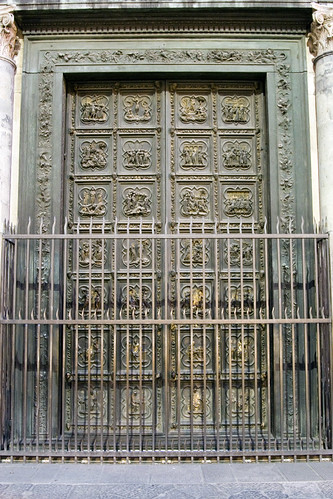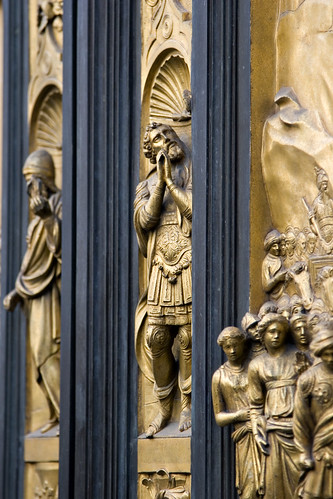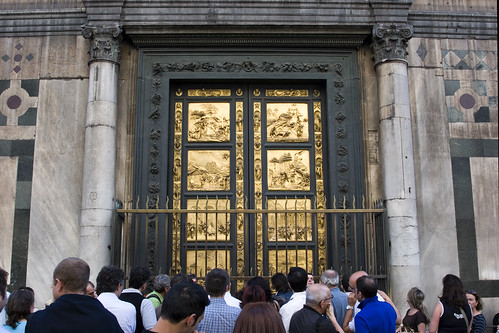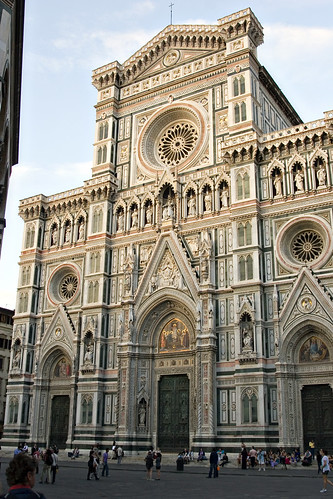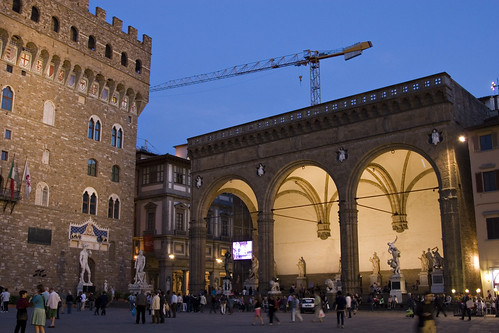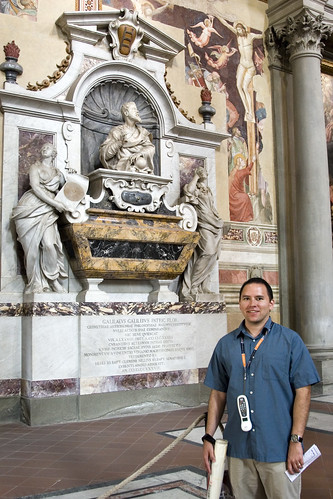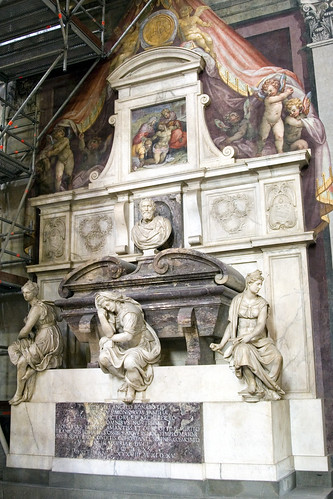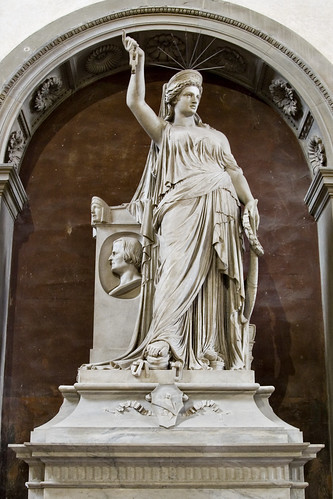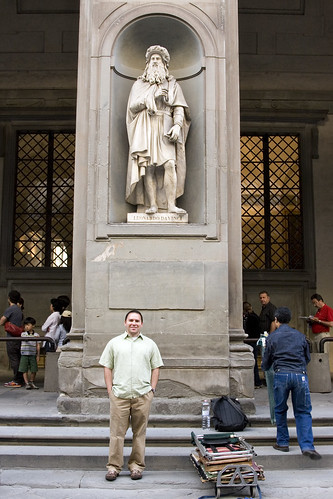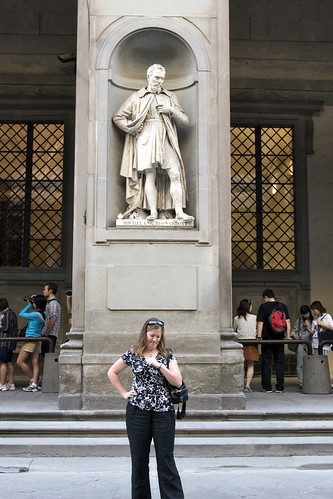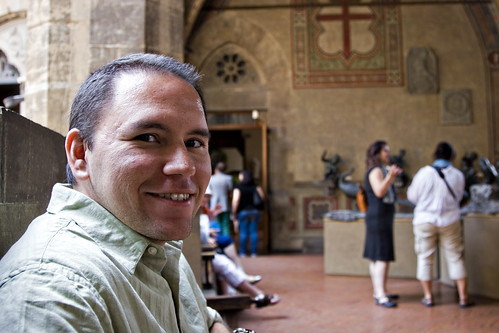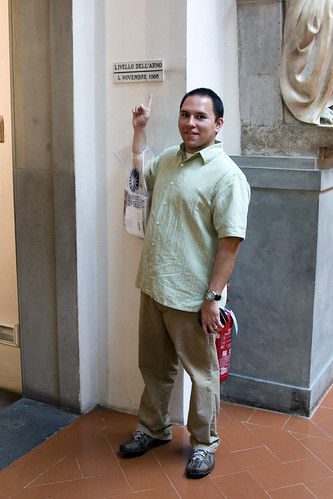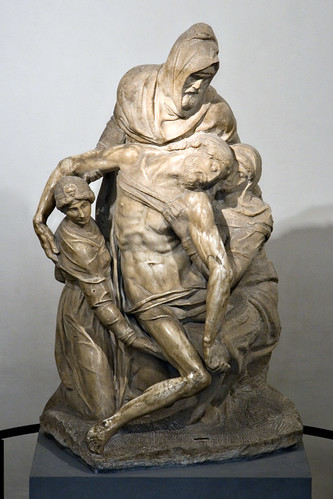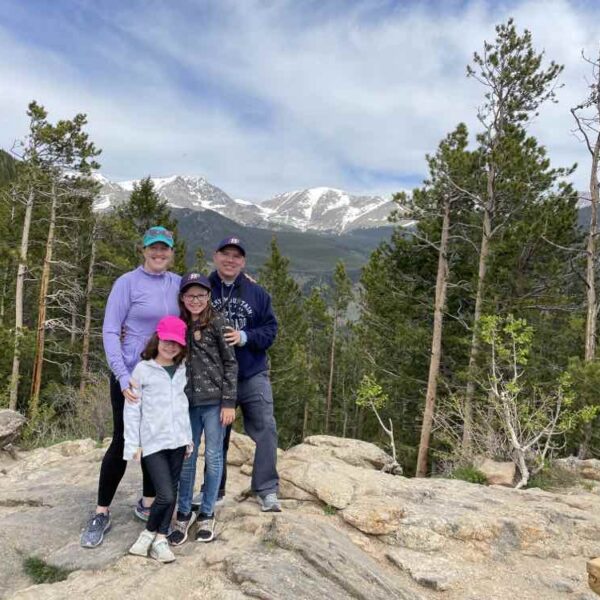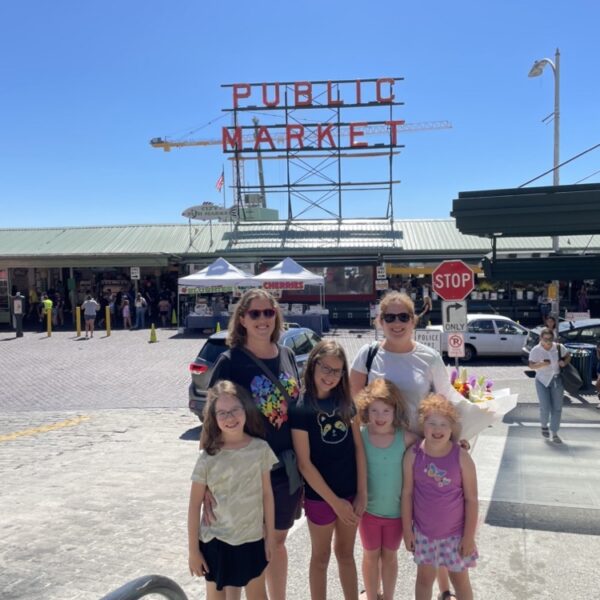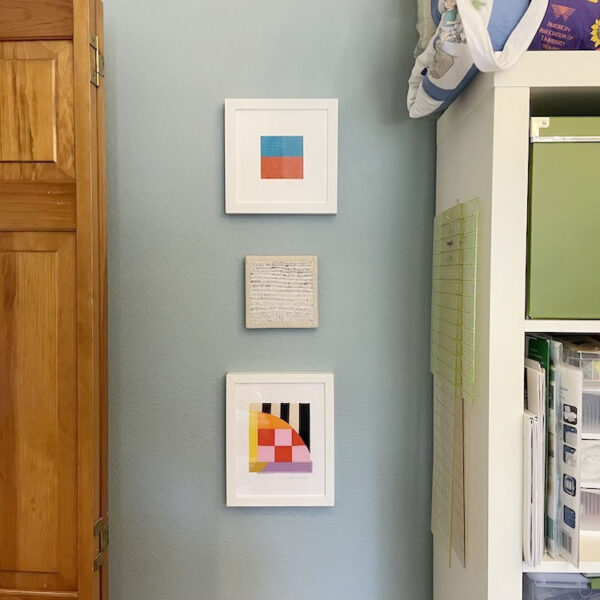Yesterday’s post turned into a love letter from me to the Duomo, but of course we did a lot of other things in Florence too. We arrived by train from Rome in the late afternoon, and after finding our hotel we headed over to the Accademia museum. I don’t have any photos, since the building itself was unremarkable and they did not allow photos inside. Now, the Accademia is pretty small and they don’t have a whole lot on display. You can see the whole thing in an hour or less, and it wouldn’t be high on my list of priorities to visit in Florence…except, well, there’s this:
 (photo from here)
(photo from here)
Yes, the Accademia is home to Michelangelo’s David. You think it looks awesome in photos, right? And it does, but: it is even MORE amazing in person. First, David is huge and on a pedestal so that he looms above you in natural light coming through the skylights above. Second, he feels so very real and lifelike, as if he could just step down off the pedestal at any moment and wander off into the streets of Florence. Sitting there staring at the David from all angles will occupy at least half of the time you spend at this museum. Another quarter of your time will be spent staring at the unfinished Michelangelo sculptures that line the hallway leading to the David, marveling at the way the figures in those marble blocks seem like they are straining to get out. I can’t get over the skill it takes to make sculptures like this. It is not a skill I have in any way, and it amazes me.
After gawking at the David for a while, we walked over to the Piazza del Duomo. (The central part of Florence is not very large, and thus very walkable. We never set foot in a vehicle of any kind in Florence. We just walked everywhere.) In addition to the obvious — the Duomo! — there are other things to admire there as well. The Baptistery directly across from Santa Maria del Fiore is famous for two large sets of bronze doors, both designed by Ghiberti in the 1400s. The first pair (above on the left; this is a replica, with the real panels now in a museum) was the result of a competition in 1401 where Ghiberti actually beat out Brunelleschi, who would of course recover and build the Duomo instead. The second pair (closeup above on the right, full photo below below) were designed 25 years later, and it’s interesting to see the change in style. The later doors became the more famous pair, especially after Michelangelo dubbed them the “Gates of Paradise.”
We also admired the facade of Santa Maria del Fiore. The church was built in the 1300s and 1400s, but the facade wasn’t added until the 1800s. It’s extremely ornate and colorful. We wandered around inside the church for a bit, but the interior, while nice, doesn’t compare to the exterior at all. The most interesting part is that Brunelleschi is actually buried below the church, and you can see his tomb…when you visit the gift shop. Ha.
After it got dark, we found ourselves in Piazza della Signoria, which is a big square right in the middle of Florence anchored by the Palazzo Vecchio.There is also a wide colonnade that leads to the Uffizi Gallery, and plenty of statues to admire. If you look on the lower left of the photo below, you can see a replica of the David. This is where the statue originally sat before it was moved into a museum for preservation.
While we were wandering around, we saw small groups of people with some kind of light/projection system. It seemed like they were setting up for some sort of show, and sure enough, we were soon treated to a light show where they projected a lot of different images and patterns onto the buildings in the piazza. I don’t really know what was going on, or what the point was, but it was cool!
The next day, we visited the Basilica di Santa Croce. It wasn’t as big as Santa Maria del Fiore, but it was chock full of interesting things — and interesting PEOPLE, since the church walls and even floor were covered with tombs. Anybody want to guess whose tomb we saw first? Hint: he’s one of Jose’s heroes.
Yes, Galileo was buried in Santa Croce after spending the latter years of his life under house arrest in Florence for defending the idea that the sun is the center of the solar system. The two female statues on either side represent astronomy and geometry, if I remember correctly. Anyone want to guess who else is buried in this church, directly across from Galileo?
Yes, Michelangelo is also here, although not by choice — he wanted to be buried in Rome, where he had done most of his major work. But the powerful Medici family wanted him in Florence, and so there he is. Apparently you did not mess with the Medicis, and they always got their way. The three females sitting around his tomb represent sculpture, painting, and architecture. Another interesting find in Santa Croce was the tomb of Niccolini featuring a sculpture by Pio Fedi that looks quite familiar — some suspect that this statue was the inspiration for the Statue of Liberty. The resemblance is definitely there.
We took a walk across Ponte Vecchio (literally “old bridge”) later that afternoon, which is lined with stores — all jewelry stores, actually, and pretty expensive jewelry stores at that! But we enjoyed browsing, and bought a few souvenirs at stores farther up the street.
We didn’t leave Florence until late afternoon, so we used our final half day to visit a couple more museums. The Uffizi Gallery was originally built as offices for the Medici family and the government of Florence, and is famous for its vast collection of Renaissance art such as Botticelli’s Birth of Venus. (No pictures allowed, again.) It’s also famous for massive crowds and long lines, which we cleverly avoided by 1) getting a reservation and 2) going first thing in the morning as soon as the gallery opened. You can see part of the line, which was already growing, behind us above as we pose with statues of Leonardo da Vinci and Michelangelo. The Uffizi was something I actually did NOT visit on my first visit to Italy in 2001, so I didn’t know what to expect. I have to admit that since I prefer sculpture to painting, the Uffizi was kind of underwhelming. I would have been a little annoyed if we’d spent hours in line to get there.
Jose at the Bargello
After the Uffizi, we visited the Bargello, a former prison turned art museum. It was a very cool building, and had a few really nice pieces including a bronze David by Donatello and a handful of Michelangelo sculptures.
Our last stop — literally, we stopped by for a half hour on our way back to the hotel to grab our bags and head to the train station — was the Museo dell’Opera del Duomo. There were a number of interesting things to see there, from the original panels of Ghiberti’s first set of bronze doors to various models and architectural drawings of the Duomo. We even saw Brunelleschi’s death mask which I have to admit was both interesting and a little creepy. On the left, Jose is pointing to a small marker that we saw in a number of churches and museums. The line indicates the level water reached when the Arno River flooded in 1966 and devastated large portions of the city, along with its art and architecture. (The Wikipedia entry on the flood is actually quite interesting, if you have time to read it.)
We also were surprised by yet another amazing Michelangelo statue that we didn’t realize was in this small museum. It’s another pieta, and while not as famous as the pieta Michelangelo created for the Vatican, it was still impressive. This one was supposedly designed for the artist’s own tomb, but he became upset with it and tried to destroy it. The figure in the back is allegedly a self-portrait. He never finished it.
We had a great time overall in Florence. Here’s the full set of pictures from that city:
[pictobrowser type=”flickr” userID=”saroy” albumID=”72157624553517846″]

